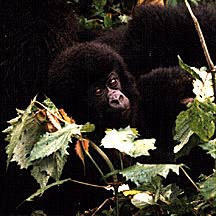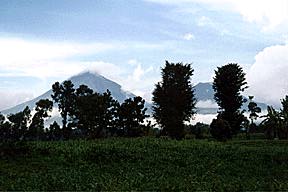
After 10 years of respite, a new assault was perpetrated last month against mountain gorillas and their very chances for survival.
 In December of 94, my husband and I visited with a
peaceful family of 25 mountain gorillas in the Virunga Mountains
of Zaire. There are no words to describe what a wonderful
experience it was to observe these majestic creatures, our
closest relatives, in their natural habitat. The hour and a half
I spent with them was to be one of my sweetest memories. But
today my memories are shattered, spoiled with blood and rage. On
August 14th, Marcel (also known as Rugabo), the beautiful
silverback leader of the group, and an adult female were shot to
death, while trying to prevent the kidnapping of an infant.
In December of 94, my husband and I visited with a
peaceful family of 25 mountain gorillas in the Virunga Mountains
of Zaire. There are no words to describe what a wonderful
experience it was to observe these majestic creatures, our
closest relatives, in their natural habitat. The hour and a half
I spent with them was to be one of my sweetest memories. But
today my memories are shattered, spoiled with blood and rage. On
August 14th, Marcel (also known as Rugabo), the beautiful
silverback leader of the group, and an adult female were shot to
death, while trying to prevent the kidnapping of an infant.
Marcel was probably the most famous gorilla after Digit, and his group was very habituated to tourists. The circumstances of the murder are still under investigation, but here is what we know today: Apparently, a ranger of the Parc National des Virungas was hired by a private collector to capture a young male gorilla. The ranger, who knew Marcel well, thought he could get away with just snatching the baby. He obviously did not count on the gorillas' protectiveness. No amount of habituation will prevent a silverback from protecting his group, or a mother her child. Now thanks to some of our fellow mens' greed and stupidity there are two more names on the list of the heroic gorillas who have sacrificed their lives at the spears and guns of poachers and collectors.
 Fortunately, the baby gorilla was retrieved from a
truck at the Uganda border and succesfully reintroduced in his
family. He was named Rafiki
("friend" in Swahili) in honor of a Nairobi-based
company who runs safaris in the area. Marcel and his lady were
buried behind the wardens hut in Djomba, in the presence of
several Zairian dignitaries. Their deaths are not only a tragedy
for their group (if there isn't a male capable of taking over the
role of silverback, the group may desintegrate and wander
aimlessly in the forest at the mercy of poachers), they put a
serious dent in the whole species' chances for survival.
Fortunately, the baby gorilla was retrieved from a
truck at the Uganda border and succesfully reintroduced in his
family. He was named Rafiki
("friend" in Swahili) in honor of a Nairobi-based
company who runs safaris in the area. Marcel and his lady were
buried behind the wardens hut in Djomba, in the presence of
several Zairian dignitaries. Their deaths are not only a tragedy
for their group (if there isn't a male capable of taking over the
role of silverback, the group may desintegrate and wander
aimlessly in the forest at the mercy of poachers), they put a
serious dent in the whole species' chances for survival.
There are only about 650 mountain gorillas left in the world, half of which live in the Parc National des Virungas in Zaire, and the other half in neighboring Rwanda and Uganda. Each time one dies, it reduces the genetic pool available for their reproduction. Before this year, there had been no gorillas killed since the murder of Dian Fossey, the famous gorilla conservationist, in 1985. Unfortunately, Marcel and his female are not the only mountain gorillas who died this year. Four were shot in Uganda in March; a silverback, named Salama, died from unknown causes in Zaire; and just a couple of weeks ago, another silverback, named Luwaya, was found shot in the Virungas. Luwaya's death brings the count to eight, a terrible loss in a population of 650.
 Most of the deaths are attributable to poachers who
kill the gorillas for their meat or to capture infants. The
problem has become acute in the past year due to the presence of
more than 750,000 Rwandan refugees in the camps of Goma near the
Parc des Virungas. On August 22nd, the Zairian soldiers tried to
force some refugees, most of them Hutu gunmen responsible for
killing about 500,000 Tutsis, back to Rwanda, but mostly
succeeded in sending 60,000 of them into the mountains to escape
the expulsions. The presence of the refugees increases the
pressure on the endangered mountain gorillas. According to a
study conducted for the UN, 18 square kilometers of forest have
already been destroyed by refugees cutting wood for fuel, and 78
square kilometers are badly damaged. Deforestation and the
invasion of refugees in the National Park puts the gorillas at
risk, not only from poaching, but also from being pushed higher
up the mountains, where they may suffer respiratory problems.
Most of the deaths are attributable to poachers who
kill the gorillas for their meat or to capture infants. The
problem has become acute in the past year due to the presence of
more than 750,000 Rwandan refugees in the camps of Goma near the
Parc des Virungas. On August 22nd, the Zairian soldiers tried to
force some refugees, most of them Hutu gunmen responsible for
killing about 500,000 Tutsis, back to Rwanda, but mostly
succeeded in sending 60,000 of them into the mountains to escape
the expulsions. The presence of the refugees increases the
pressure on the endangered mountain gorillas. According to a
study conducted for the UN, 18 square kilometers of forest have
already been destroyed by refugees cutting wood for fuel, and 78
square kilometers are badly damaged. Deforestation and the
invasion of refugees in the National Park puts the gorillas at
risk, not only from poaching, but also from being pushed higher
up the mountains, where they may suffer respiratory problems.
One of the most present problems, however, comes from the drop in tourism that all this turmoil has caused. The National Parks get most of their revenues from the tourists who come see the gorillas. In Djomba, a visit costs $120 per person and up to 8 tourists go each day. If there are no tourists, close to a $1,000 a day and $365,000 a year is lost to the Park authorities and, therefore, taken away from the gorillas' protection. If the Park is not protected, there will be no limits to the damage made to the mountain gorillas' only habitat on earth, which would undoubtedly lead to their extinction.
You probably can't solve the refugee problem in Zaire, but there are ways you can help. Visiting the mountain gorillas is the best way to relieve their plight. Not only will you help guarantee their continued protection, you will see for yourself what wonderful and gentle creatures mountain gorillas are. Although going to Rwanda is not recommended, you can still visit the gorillas in Uganda or Zaire. As Chris McDonald from Rafiki Africa puts it: "We have experienced no increased levels of risk at Djomba and the locals remain as friendly as ever. The fact is that the gorilla sanctuary is approached from the Uganda side of the Virunga mountains and the problems facing Zaire, as far as the 1,000,000 refugees from Rwanda are concerned, may as well be thousands of miles away." If you would like to go, please contact Kilimanjaro Adventure Travel on the web at http://www.kilimanjaro.com.
You can also help by sending donations to various animal protection groups. The World Society for the Protection of Animals is running the EscApe campaign, specifically dedicated to the survival of the great apes. We are also hoping to start a "Marcel Fund" in connection with the Dian Fossey Gorilla Fund (UK), in order to build a visitor education center that will help the public understand the gorillas, their habitat, and future survival. Please check back with us to see what the status is and how you can help.